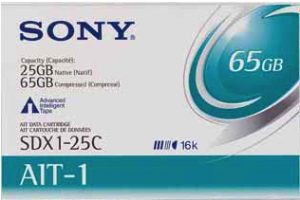History (1996): Sony With New 8mm AIT
To combat DLT and Mammoth
By Jean Jacques Maleval | June 29, 2021 at 2:31 pmSony makes no bones about targeting Quantum’s DLT and Exabyte’s Mammoth with the announcement of its new SDX-300 8mm drive, whose specs are intriguing: 25GB native capacity-a record in the 3.5-inch form factor and a transfer rate of 3MB/s.

Within Sony’s new 8mm line of technology, dubbed AIT (Advanced Intelligent Tape), the most interesting development is perhaps not the drive but the “intelligent” cassette, named MIC (Memory in Cassette), that Sony intends to present to the standardization organizations ECMA and ISO.
The product appears to be an 8mm cassette identical to that of Exabyte or Video 8. But additionally, it offers the innovation of a tiny 16Kb flash (hence erasable) memory which offers numerous advantages. One could almost think of the cassette as containing two levels of memory, with the first in the tape itself, and the second in the EEPROM, which enhances data management and access, since its contents can be read directly and rapidly ahead of the tape.
Usually, when a cassette is inserted in the drive, it must be rewound in order to locate the content labels at the beginning of the tape. With Sony’s MIC, this information may now be found in h flash memory. Thus, the average access time to any point on the tape is cut in half, from 54 to 27s. It is quite likely that future designers of automated libraries will also want to make use of such a flash memory, thus making it possible to dispense with barcode readers in order to verify if the correct cassette has been inserted in a given drive, since the content labels are contained in solid-state memory.
The flash information is read by the drive (and then passed on to the computer via SCSI commands) by means of a special 5-brush contact. AIT media, already in use in Hi-8 professional video but not in storage, is an advanced metal evaporated tape 8mm wide and 170m long with 2 layers of evaporated cobalt that, according to Sony, has no binder for magnetic particles, which reduces head and media wear.
The manufacturer announced a head life of 30,000 hours and 20,000 media uses, plus a 30-year media archival life.
The cassette will obviously cost more: $99 retail price.
One other drawback to the new drive that Exabyte will no doubt be quick to point out the new MIC is not backward compatible and will consequently eject automatically old 8mm cassettes that are inserted.
Sony perfected a new recording format for AIT that is similar to the 4mm DDS format and can provide up to 256 on-tape partitions with new ECC. The SDX-300 drive is equipped with a helical scan drum, 4cm in diameter, which contains 2 MIG writing heads and 2 ferrite reading heads, and spins at only 4,800 rpm, recording at 116Kbpi and 268Mb per square inch.
As on the DDS-2 drives, the device has a head cleaner that is automatically activated by the firmware when error rates become excessive.
For data compression, Sony adopted the new ALDC chip that IBM uses on its Magstar (rather than the IDRC used on Exabyte’s 3490), which yields better results (2.6 to 1, according to Sony) and supports higher transfer rates.
The first drives should be available in July, in internal or external versions, but without DC or the intelligent MIC cassette. Data compression features will not be finished before September, and the MIC cassette unit will be ready in January 1997. Suggested list price for the SCSI-2 SDX-300 with DC is $4,995.
Sony anticipates manufacturing “several thousands” per month.
An autoloader with 4 cassettes within a 5,25-inch form factor will be available in March 1997.
The big question all this raises is, why suddenly is Sony ready to battle with its major 8mm mechanism customer, Exabyte, for whom Sony has supplied a mountain of devices since 1987 (along with Hitachi)? The answer may be found by looking back to about 3 or 4 years ago, when the Colorado firm first considered building a new high performance 8mm drive. At that time, Sony made an offer, the SDX-300, which Exabyte turned down.
“They wanted to go their own way“, said a Sony representative.
Incompatibility with old 8mm cartridges may also have been a factor in Exabyte’s decision to pass on the Sony device.
Sony summarizes its own decision to join the fray in the following way: current technology limited too severely the future evolution of the specs, which prompted a complete rethinking of the drive design, with an entirely new tape. From its new base, Sony expects to reach 50GB and 6MB/s in 1995 and 100GB and 12MB/s by the year 2000.
Note that Sony will end up taking as much time as Exabyte to realize its final product.
It seems clear, in conclusion, that despite a growing demand for high capacity backup, there will not be room for 3 different formats (Exabyte, Quantum and Sony), mutually incompatible, without mentioning also: 1/ Tandberg Data’s 13GB QIC, 2/ IBM’s half-inch NTP cartridge with the impending release of compatible units far less costly (around $10,000 end user price), 3/ the 4mm DDS-3 which should arrive before the end of the year, along with the Travan TR4, both of which nonetheless fall into a different category.
It seems that everyone is chasing Exabyte’s success, each hoping to ride the second wave of high performance and capacity. The wave is probably big enough for a few more, but not all. Difficult to avoid collisions, if not outright drownings. Even the lifeguard, ostensibly Exabyte, isn’t certain to make it all the way in.
This article is an abstract of news published on the former paper version of Computer Data Storage Newsletter on issue 100, published on May 1996.














 Subscribe to our free daily newsletter
Subscribe to our free daily newsletter

